
Page 1 of 5
Things to Consider and FAQ’s When Planning to Purchase a Safe Room
Which is better...an underground shelter or an above ground shelter?
Studies have shown that you are just as safe in an approved/certified above ground safety shelter as in
a below ground shelter and in certain situations you could be safer.
Cons for underground shelters:
•
Susceptible to stresses and strains of the soil freezing in the wintertime.
•
Susceptible to floating if the high water table is too high.
•
Expensive to dig if bedrock exists.
•
Could flood from rain or broken water pipes.
Pros for above ground shelters:
•
Less ground preparation required.
•
Can be entered easily.
•
Less chance of flooding from rain and broken pipes.
•
Less expensive to install in most cases.
Safe Rooms and Storm Shelters?
There is no law or regulation that requires a manufacturer to have their shelter tested and certified.
Some shelter manufacturers are producing storm shelters or safe rooms that are not certified. The
buyer should always ask if the manufacturer’s products have been tested to FEMA and ICC
requirements for Safe Rooms and/or verified by NSSA (the National Storm Shelter Association).
It is logical that debris impact testing would be more important for above-ground shelters, and ground-
stress testing would be more important for below-ground shelters. Since most communities would
require a building permit for such a project, a family would need to have a building inspector examine
plans for the shelter. Requirements can vary from community to community may require the approval of
a professional engineer. The Swisher ESP Safety Shelter does qualify as a FEMA Safe Room based
upon compliance with ICC-500, FEMA 361 and FEMA 320.
The Texas Tech National Wind Institute is the only facility approved by FEMA to perform debris impact
testing. ESP Safety Shelters have passed all tests at Texas Tech NWI and underwent rigorous design
analysis to withstand 250 mph winds from any direction as seen in an EF-5 Tornado.

Page 2 of 5
What do I look for when I first start searching for a Storm Shelter / Safe Room?
The most important thing to look for is a company who has had their shelter’s design and construction
verified by NSSA. Quality verification involves having the shelters not only debris impact tested at
Texas Tech’s National Wind Institute, but also a written structural wind engineer evaluation of the uplift
and overturn forces applied to a Safe Room or Safety Shelter design in a high wind event. The ESP
Safety Shelter has had ALL of the above.
What is the safest shelter you offer?
All ESP Safety Shelters have been designed, engineered, professionally evaluated and tested to
surpass the requirements needed to withstand an EF-5 tornado. Since every shelter we offer exceeds
the standards set by the NSSA/ICC-500 and FEMA P361, no one shelter size is safer than another. If
you can decide which size shelter is right for you and your family, our quality control program ensures
that no matter your choice, your safety and security will be paramount.
What size Safe Room should I get?
FEMA P-320, FEMA P-361 and ICC-500 recommend 3 Sq/Ft per occupant for single and double family
dwellings and 5 Sq/Ft for other residential host buildings / private business. Additional considerations in
determining what size is right for you are the length of time spent in your shelter and/or if you are
planning on using your shelter for valuables or dry goods storage.
Model No.
Internal Dimensions
SqFt
Occupancy Occupancy
External Dimensions
(5Sqft/Person)
(3Sqft/Person)
Business Private
W" D" H" Family W" D" H"
SR84X039G
80 35 76 19.4
3 6 84 39 78.188
SR84X054G
80 50 76 27.8
5 9 84 54 78.188
SR84X084G
80 80 76 44.4
8 14 84 84 78.188
SR84X114G
80 110 76 61.1
12 20 84 114 78.188
SR84X144G
80 140 76 77.8
15 25 84 144 78.188

Page 3 of 5
As my family grows can the ESP Safety Shelter be enlarged?
Yes it can. Additional Expansion Kits P/N 20206 that will increase the depth of your shelter from 39” to
54”, 84”, 114” and 144”. *Please note that expanding your ESP Safety Shelter from the original
purchased size will require a new instillation checklist and inspection to ensure your shelter is providing
the Near Absolute protection it is designed for.
What is the best location for my shelter?
Tornadoes typically track southwest to northeast; however, when viewing the devastation and debris
left behind, we can only be certain of one conclusion; TORNADOES ARE UNPREDICTABLE AND
OUTSIDE OUR CONTROL. What we can control in these life threatening events, is how quickly we
can get to our safe rooms. The best location for your shelter is one that can be easily and safely
accessed. We understand that you won’t need to use your shelter daily, but when you do, ease of
accessibility is critical.
How hard is it to install the ESP Safety Shelter? Can I do it myself or do I need to hire someone?
The ESP Safety Shelter is very easy to install with the assistance of one or two additional people (DIY),
your ESP Safety Shelter comes with detailed assembly instructions and a comprehensive installation
checklist. However, you could also hire a professional contractor to complete the instillation. Swisher
Acquisition Inc. does not endorse or approve installation contractors. Some helpful hints in locating
contractors is located inside your ESP Installation Manual. No matter who performs the installation, the
Inspection Checklist sign-off procedure is critical to ensuring that your ESP Safety Shelter provides
Near Absolute Protection during a high wind event.
What type of concrete foundation is required for your shelter?
To obtain Near Absolute Protection from 250 mph EF-5 tornado winds the ESP Safety Shelter should
be secured to an adequate concrete slab as outlined in your shelter’s Installation Manual.
• Minimum Concrete Requirements:
o Slab Thickness: 5 inches
o Compressive Strength: 2,500 psi
o Reinforcement: #4 (1/2”) rebar on 24” centers.
An additional overhang of concrete beyond the size of the shelter is required based on the shelter
purchased (see installation manual for details). Any deviation from these minimum requirements will
require an independent evaluation performed by a structural engineer.
What kind of steel do you use in your tornado storm shelters?
ESP Safety Shelters are made of 3/16” hot rolled A36 Steel. They have been tested at Texas Tech’s
National Wind Institute and proven to withstand 15lb 2x4’s at 100mph. This is equivalent to a 250 mph
tornado wind force, per FEMA 361.

Page 4 of 5
Do you offer financing?
Yes! We understand the number one obstacle to owning a safe room is cost. That is why we are proud
to offer affordable financing to families in several states. Contact us today and find out how we can
make the purchase of America’s best safe room a reality.
What type of Warranty do you provide?
ESP Safety Shelters have a 5 Year Manufactures Defect and Limited Lifetime Warranty against
Tornado damage. See the ESP Product Manual for complete Warranty details.
What is NSSA?
NSSA is the National Storm Shelter Association. Members of the National Storm Shelter Association
(NSSA) have subjected their products to rigorous testing and evaluation to assure quality. Members
must meet stringent quality considerations and pledge sound business practices. You may confidently
do business with NSSA members.

Page 5 of 5
What Does NSSA Offer You? To a shelter consumer, NSSA offers:
• Identity of shelter producers who provide quality-verified products
• Labels on quality-verified products to recognize quality
• ICC/NSSA standard that establishes quality criteria
• Information and education via seminars, web pages, and responses to inquiries
• Checklists of important elements of shelter quality
• Advocacy for incentive programs for shelter construction
Is FEMA Funding available?
To determine if FEMA funding is available in your area contact your local, county or State Emergency
Management Agency.
After major tornado outbreaks FEMA may release funding to cover a portion of the cost of residential
Safe Rooms. To be eligible for a $2000 rebate (under FEMA’ Project Impact, designed to help victims
rebuild after natural disasters) the product must be compliant to the requirements for a Safe Room
under FEMA 361 and FEMA 320. Shelter manufacturers may or may not have this done, as it can cost
thousands of dollars, and can require extensive reworking of material or design elements in the
structure. ESP Safety Shelters qualify as Safe Rooms under FEMA 361 and are approved by NSSA
(National Storm Shelter Association) as being such.
FEMA criteria:
FEMA is the Federal Emergency Management Administration. It oversees and coordinates disaster
relief, provides remediation funding after disasters, sets recommended safety/design criteria for Safe
Rooms, and studies the effects of natural disasters.
The FEMA criteria for storm shelters includes wind loads and debris impact. It’s a goal that shelter
manufacturers should design for, but it is certainly more relevant for above-ground shelters than
underground shelters.
This is a good time to remind everyone that there are always “companies” that rush in after a disaster
to take advantage of the victims of that disaster. It is sad but true. There are companies that have
products that can be “turned into” storm shelters, but these shelters may not have been designed, built
and tested to the FEMA P-361 and FEMA P-320 or ICC500. They have jumped into the shelter
business, adapting these products somewhat and these shelters may not provide near absolute
protection.
-
 1
1
-
 2
2
-
 3
3
-
 4
4
-
 5
5
Swisher SR84X114G FAQ
- Type
- FAQ
Ask a question and I''ll find the answer in the document
Finding information in a document is now easier with AI
Related papers
-
Swisher SR84X144G Operating instructions
-
Swisher SR84X144G User manual
-
Swisher SR84X144G Owner's manual
-
Swisher SR114X84G Owner's manual
-
Swisher SR84X039G Specification
-
Swisher SR84X144G User manual
-
Swisher SR114X84G User manual
-
Swisher SR84X039G User manual
-
Swisher SR114X84G User manual
-
Swisher SR114X84G User guide
Other documents
-
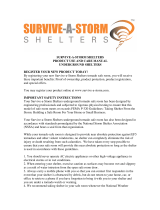 Survive-a-Storm Shelters SASGM0804 User manual
Survive-a-Storm Shelters SASGM0804 User manual
-
Survive-a-Storm Shelters SASAS04D User manual
-
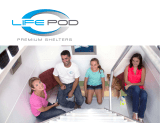 Life Pod Shelters FP-4 User guide
Life Pod Shelters FP-4 User guide
-
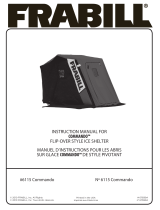 Frabill Commando 6115 User manual
Frabill Commando 6115 User manual
-
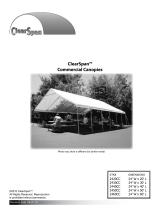 ClearSpan 2440CC User manual
ClearSpan 2440CC User manual
-
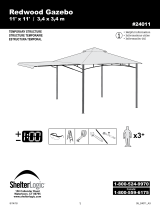 ShelterLogic 24011 User manual
ShelterLogic 24011 User manual
-
ShelterLogic 74342.0 Installation guide
-
 ShelterIT 71010 User manual
ShelterIT 71010 User manual
-
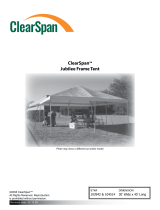 ClearSpan Jubilee Frame Tent Assembly Instructions Manual
ClearSpan Jubilee Frame Tent Assembly Instructions Manual
-
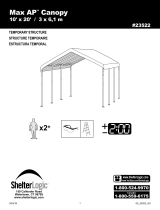 ShelterLogic 23522 Owner's manual
ShelterLogic 23522 Owner's manual












